Child Behavior and Safety Practices Assessment Report
VerifiedAdded on 2020/03/01
|14
|2545
|45
Homework Assignment
AI Summary
This assignment presents a comprehensive assessment of child behavior and safety practices within an early childhood education setting. The first part of the assignment focuses on developing a behavior plan for a 3-year-old child named Charlie Brown, addressing concerns about his aggressive behaviors such as beating and spitting on others. It includes detailed observations, identification of triggers, and strategies for collaborating with the family to address these behaviors. The plan outlines alternative behaviors, long-term goals, and short-term objectives, along with strategies for minimizing factors that maintain the concerning behaviors. The second part of the assignment comprises reflections on journal entries related to various aspects of safety and care, including hazard communication, emergency response coordination, supervision strategies, infection control, promoting children's well-being, and communication with families about children's development. Each journal entry provides a description of the situation, the actions taken, and reflections on the effectiveness of the approach, along with links to relevant NQF, EYLF, and NQS areas.
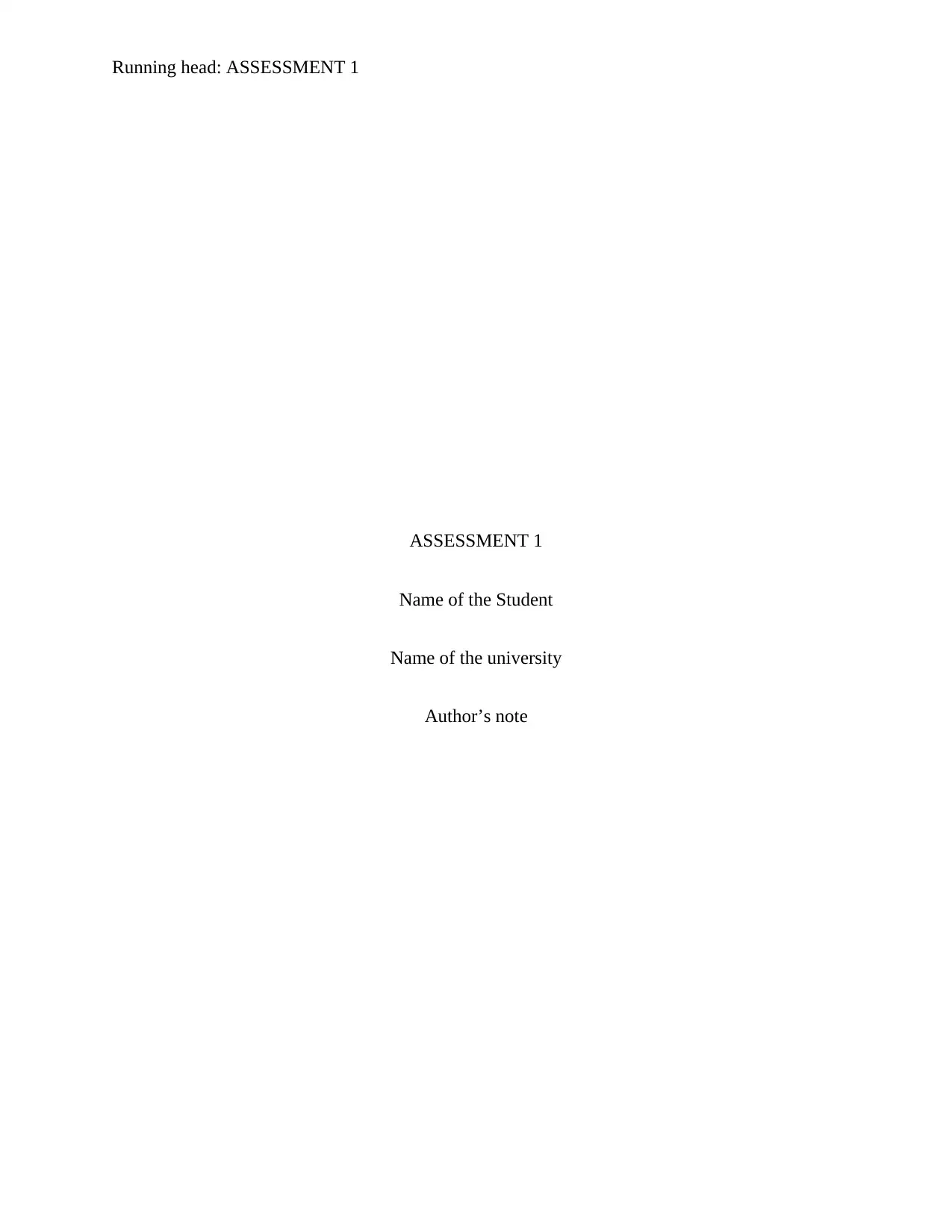
Running head: ASSESSMENT 1
ASSESSMENT 1
Name of the Student
Name of the university
Author’s note
ASSESSMENT 1
Name of the Student
Name of the university
Author’s note
Paraphrase This Document
Need a fresh take? Get an instant paraphrase of this document with our AI Paraphraser
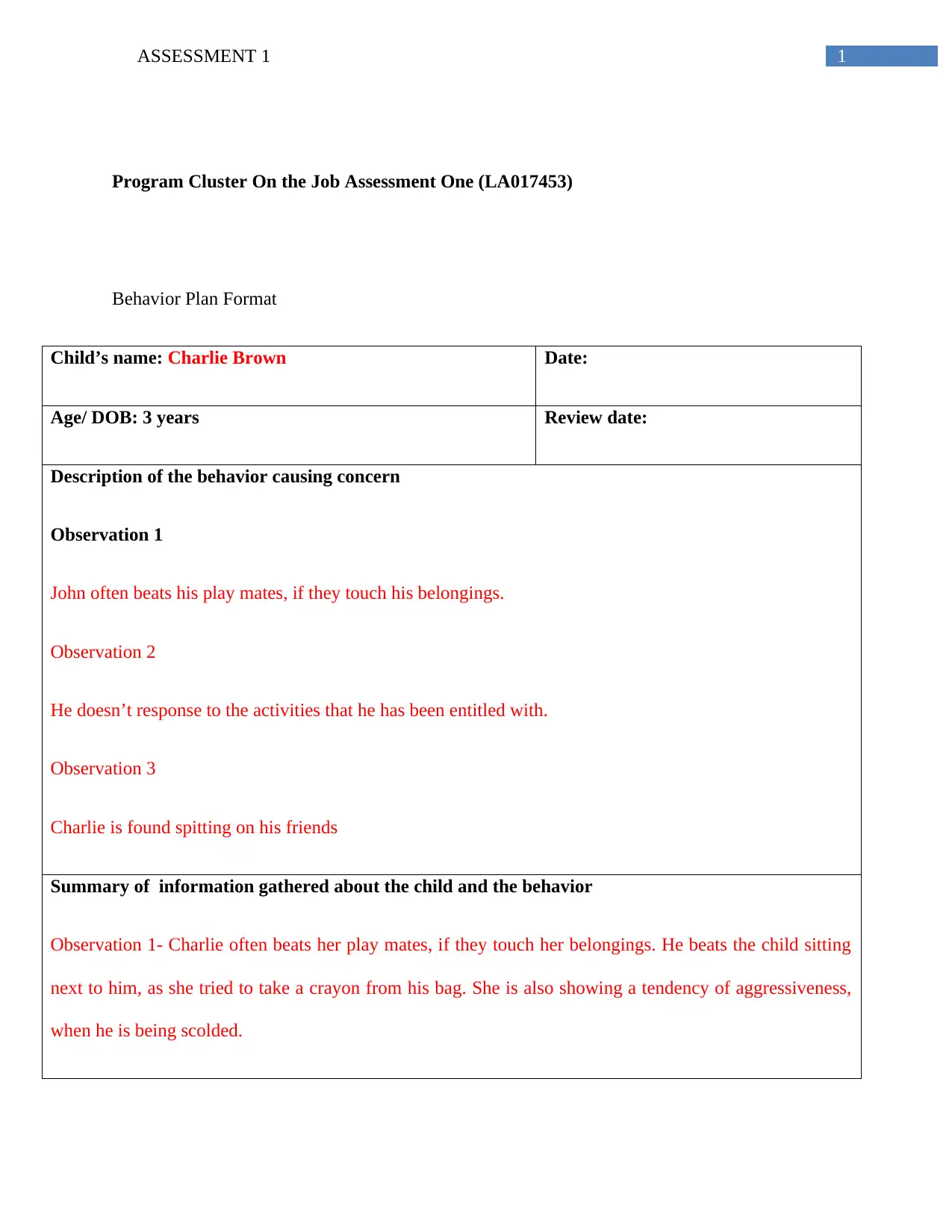
1ASSESSMENT 1
Program Cluster On the Job Assessment One (LA017453)
Behavior Plan Format
Child’s name: Charlie Brown Date:
Age/ DOB: 3 years Review date:
Description of the behavior causing concern
Observation 1
John often beats his play mates, if they touch his belongings.
Observation 2
He doesn’t response to the activities that he has been entitled with.
Observation 3
Charlie is found spitting on his friends
Summary of information gathered about the child and the behavior
Observation 1- Charlie often beats her play mates, if they touch her belongings. He beats the child sitting
next to him, as she tried to take a crayon from his bag. She is also showing a tendency of aggressiveness,
when he is being scolded.
Program Cluster On the Job Assessment One (LA017453)
Behavior Plan Format
Child’s name: Charlie Brown Date:
Age/ DOB: 3 years Review date:
Description of the behavior causing concern
Observation 1
John often beats his play mates, if they touch his belongings.
Observation 2
He doesn’t response to the activities that he has been entitled with.
Observation 3
Charlie is found spitting on his friends
Summary of information gathered about the child and the behavior
Observation 1- Charlie often beats her play mates, if they touch her belongings. He beats the child sitting
next to him, as she tried to take a crayon from his bag. She is also showing a tendency of aggressiveness,
when he is being scolded.
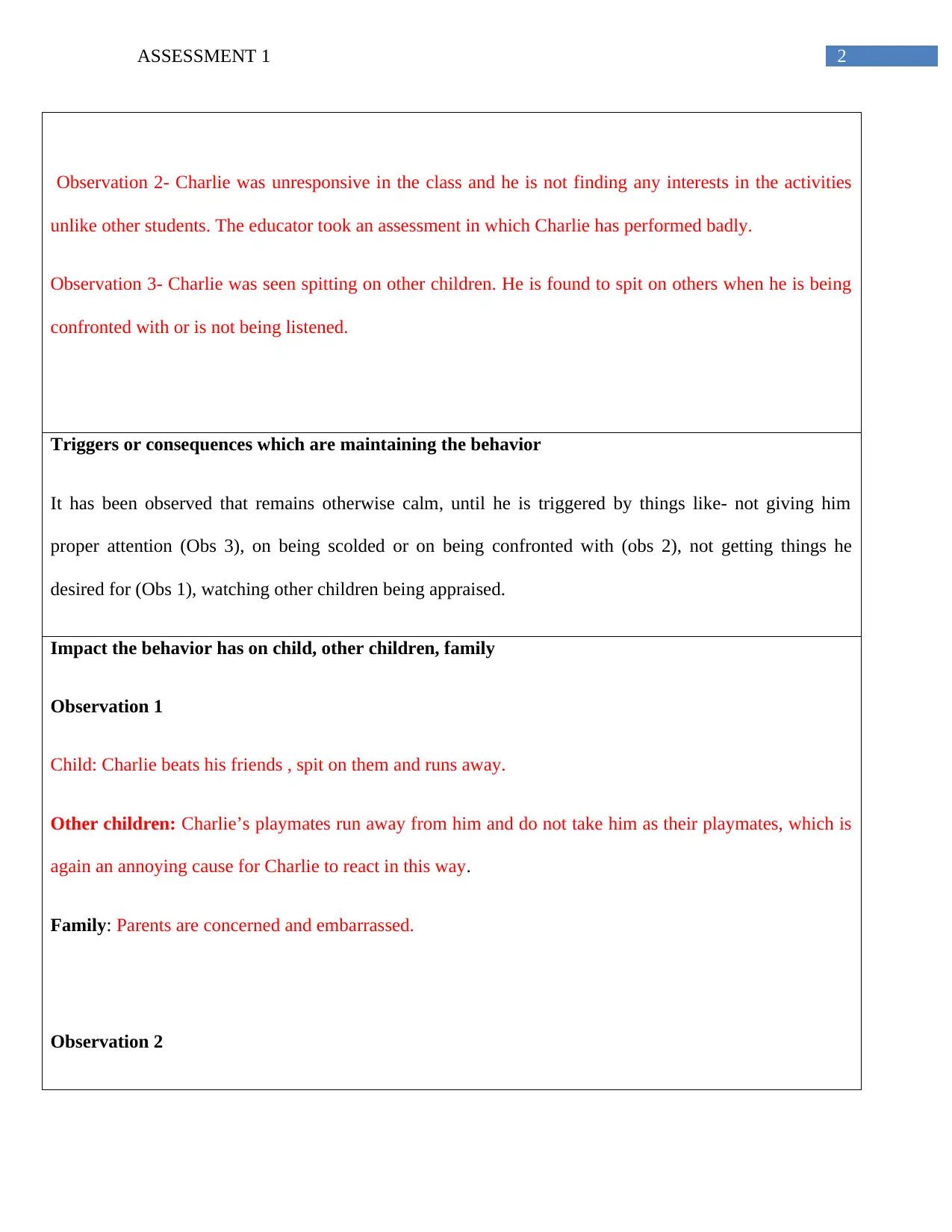
2ASSESSMENT 1
Observation 2- Charlie was unresponsive in the class and he is not finding any interests in the activities
unlike other students. The educator took an assessment in which Charlie has performed badly.
Observation 3- Charlie was seen spitting on other children. He is found to spit on others when he is being
confronted with or is not being listened.
Triggers or consequences which are maintaining the behavior
It has been observed that remains otherwise calm, until he is triggered by things like- not giving him
proper attention (Obs 3), on being scolded or on being confronted with (obs 2), not getting things he
desired for (Obs 1), watching other children being appraised.
Impact the behavior has on child, other children, family
Observation 1
Child: Charlie beats his friends , spit on them and runs away.
Other children: Charlie’s playmates run away from him and do not take him as their playmates, which is
again an annoying cause for Charlie to react in this way.
Family: Parents are concerned and embarrassed.
Observation 2
Observation 2- Charlie was unresponsive in the class and he is not finding any interests in the activities
unlike other students. The educator took an assessment in which Charlie has performed badly.
Observation 3- Charlie was seen spitting on other children. He is found to spit on others when he is being
confronted with or is not being listened.
Triggers or consequences which are maintaining the behavior
It has been observed that remains otherwise calm, until he is triggered by things like- not giving him
proper attention (Obs 3), on being scolded or on being confronted with (obs 2), not getting things he
desired for (Obs 1), watching other children being appraised.
Impact the behavior has on child, other children, family
Observation 1
Child: Charlie beats his friends , spit on them and runs away.
Other children: Charlie’s playmates run away from him and do not take him as their playmates, which is
again an annoying cause for Charlie to react in this way.
Family: Parents are concerned and embarrassed.
Observation 2
⊘ This is a preview!⊘
Do you want full access?
Subscribe today to unlock all pages.

Trusted by 1+ million students worldwide
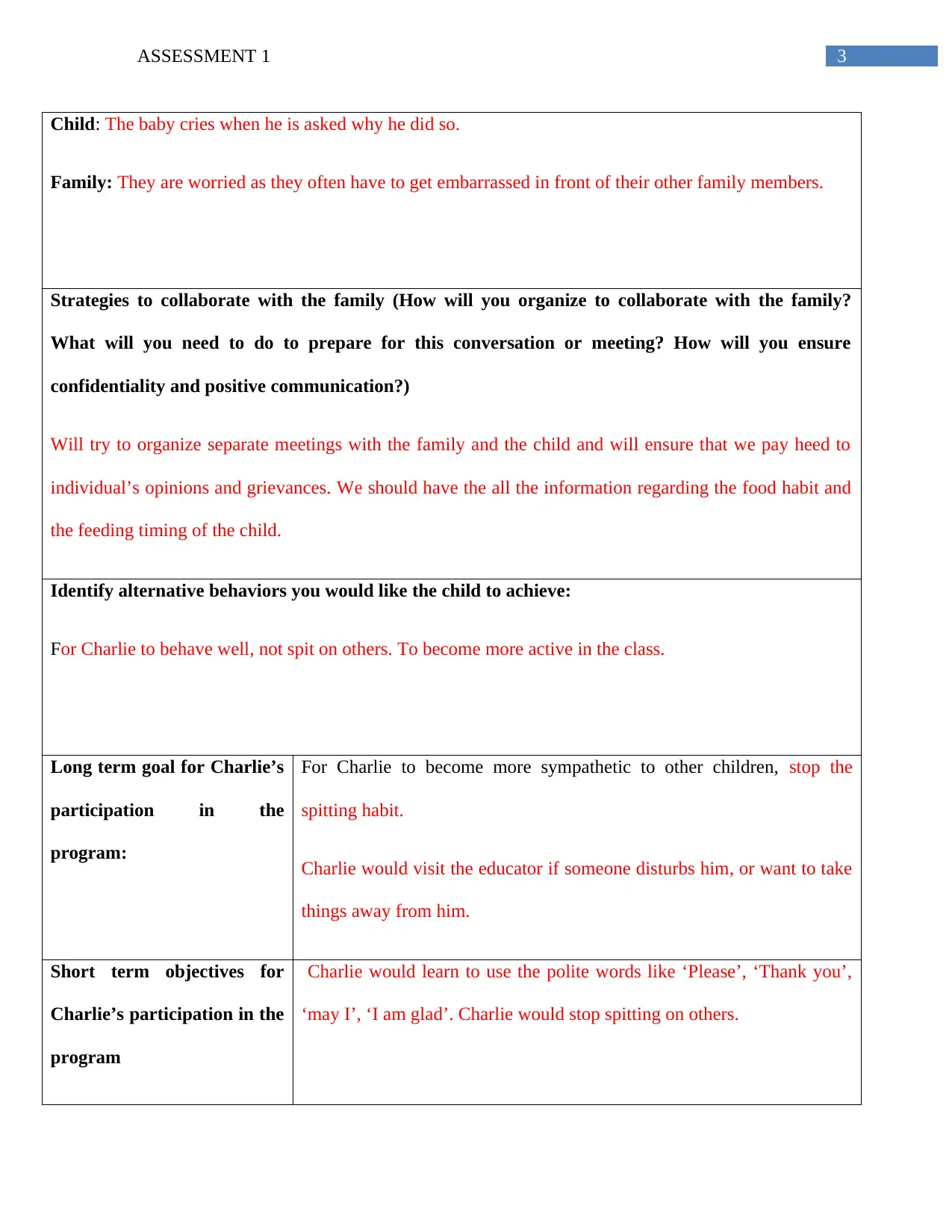
3ASSESSMENT 1
Child: The baby cries when he is asked why he did so.
Family: They are worried as they often have to get embarrassed in front of their other family members.
Strategies to collaborate with the family (How will you organize to collaborate with the family?
What will you need to do to prepare for this conversation or meeting? How will you ensure
confidentiality and positive communication?)
Will try to organize separate meetings with the family and the child and will ensure that we pay heed to
individual’s opinions and grievances. We should have the all the information regarding the food habit and
the feeding timing of the child.
Identify alternative behaviors you would like the child to achieve:
For Charlie to behave well, not spit on others. To become more active in the class.
Long term goal for Charlie’s
participation in the
program:
For Charlie to become more sympathetic to other children, stop the
spitting habit.
Charlie would visit the educator if someone disturbs him, or want to take
things away from him.
Short term objectives for
Charlie’s participation in the
program
Charlie would learn to use the polite words like ‘Please’, ‘Thank you’,
‘may I’, ‘I am glad’. Charlie would stop spitting on others.
Child: The baby cries when he is asked why he did so.
Family: They are worried as they often have to get embarrassed in front of their other family members.
Strategies to collaborate with the family (How will you organize to collaborate with the family?
What will you need to do to prepare for this conversation or meeting? How will you ensure
confidentiality and positive communication?)
Will try to organize separate meetings with the family and the child and will ensure that we pay heed to
individual’s opinions and grievances. We should have the all the information regarding the food habit and
the feeding timing of the child.
Identify alternative behaviors you would like the child to achieve:
For Charlie to behave well, not spit on others. To become more active in the class.
Long term goal for Charlie’s
participation in the
program:
For Charlie to become more sympathetic to other children, stop the
spitting habit.
Charlie would visit the educator if someone disturbs him, or want to take
things away from him.
Short term objectives for
Charlie’s participation in the
program
Charlie would learn to use the polite words like ‘Please’, ‘Thank you’,
‘may I’, ‘I am glad’. Charlie would stop spitting on others.
Paraphrase This Document
Need a fresh take? Get an instant paraphrase of this document with our AI Paraphraser
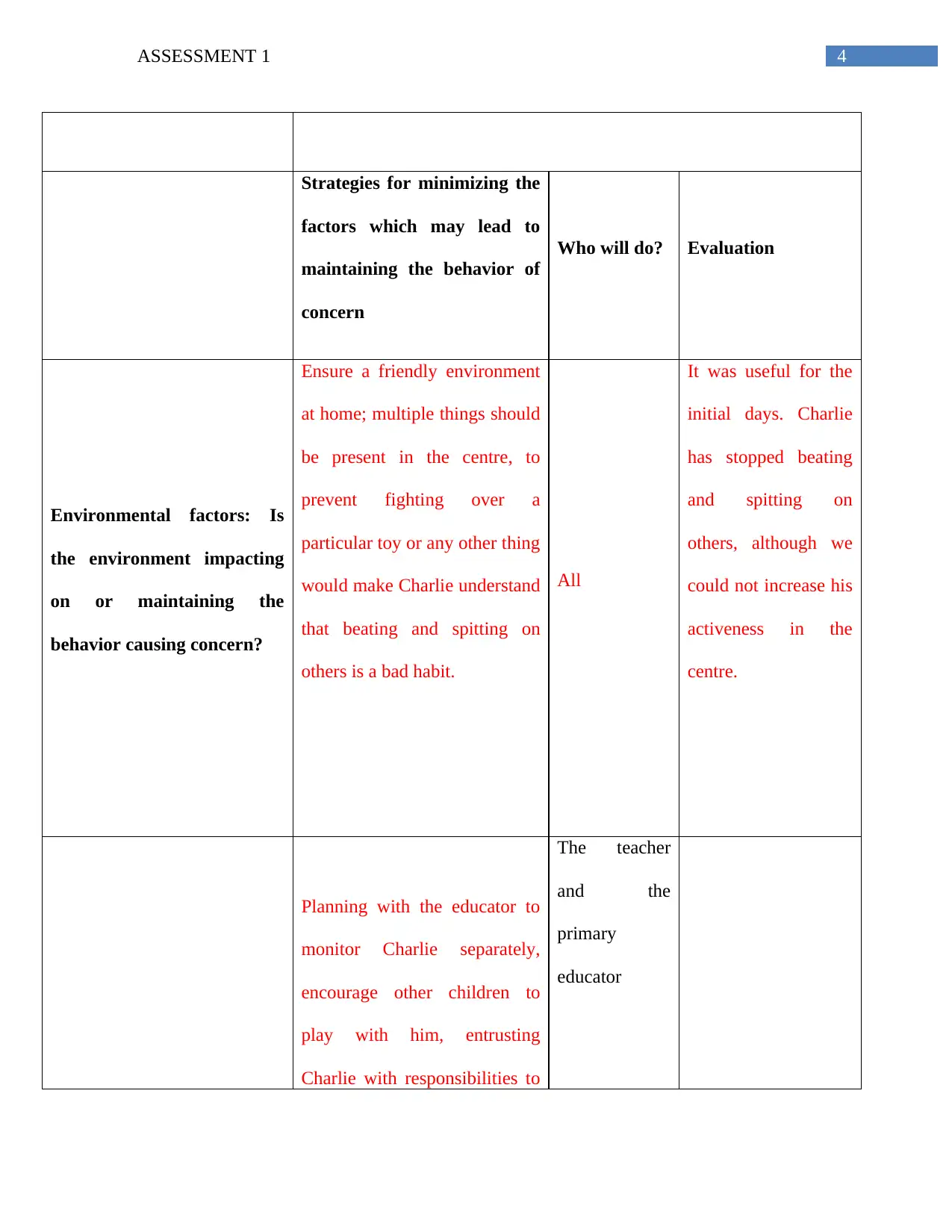
4ASSESSMENT 1
Strategies for minimizing the
factors which may lead to
maintaining the behavior of
concern
Who will do? Evaluation
Environmental factors: Is
the environment impacting
on or maintaining the
behavior causing concern?
Ensure a friendly environment
at home; multiple things should
be present in the centre, to
prevent fighting over a
particular toy or any other thing
would make Charlie understand
that beating and spitting on
others is a bad habit.
All
It was useful for the
initial days. Charlie
has stopped beating
and spitting on
others, although we
could not increase his
activeness in the
centre.
Planning with the educator to
monitor Charlie separately,
encourage other children to
play with him, entrusting
Charlie with responsibilities to
The teacher
and the
primary
educator
Strategies for minimizing the
factors which may lead to
maintaining the behavior of
concern
Who will do? Evaluation
Environmental factors: Is
the environment impacting
on or maintaining the
behavior causing concern?
Ensure a friendly environment
at home; multiple things should
be present in the centre, to
prevent fighting over a
particular toy or any other thing
would make Charlie understand
that beating and spitting on
others is a bad habit.
All
It was useful for the
initial days. Charlie
has stopped beating
and spitting on
others, although we
could not increase his
activeness in the
centre.
Planning with the educator to
monitor Charlie separately,
encourage other children to
play with him, entrusting
Charlie with responsibilities to
The teacher
and the
primary
educator
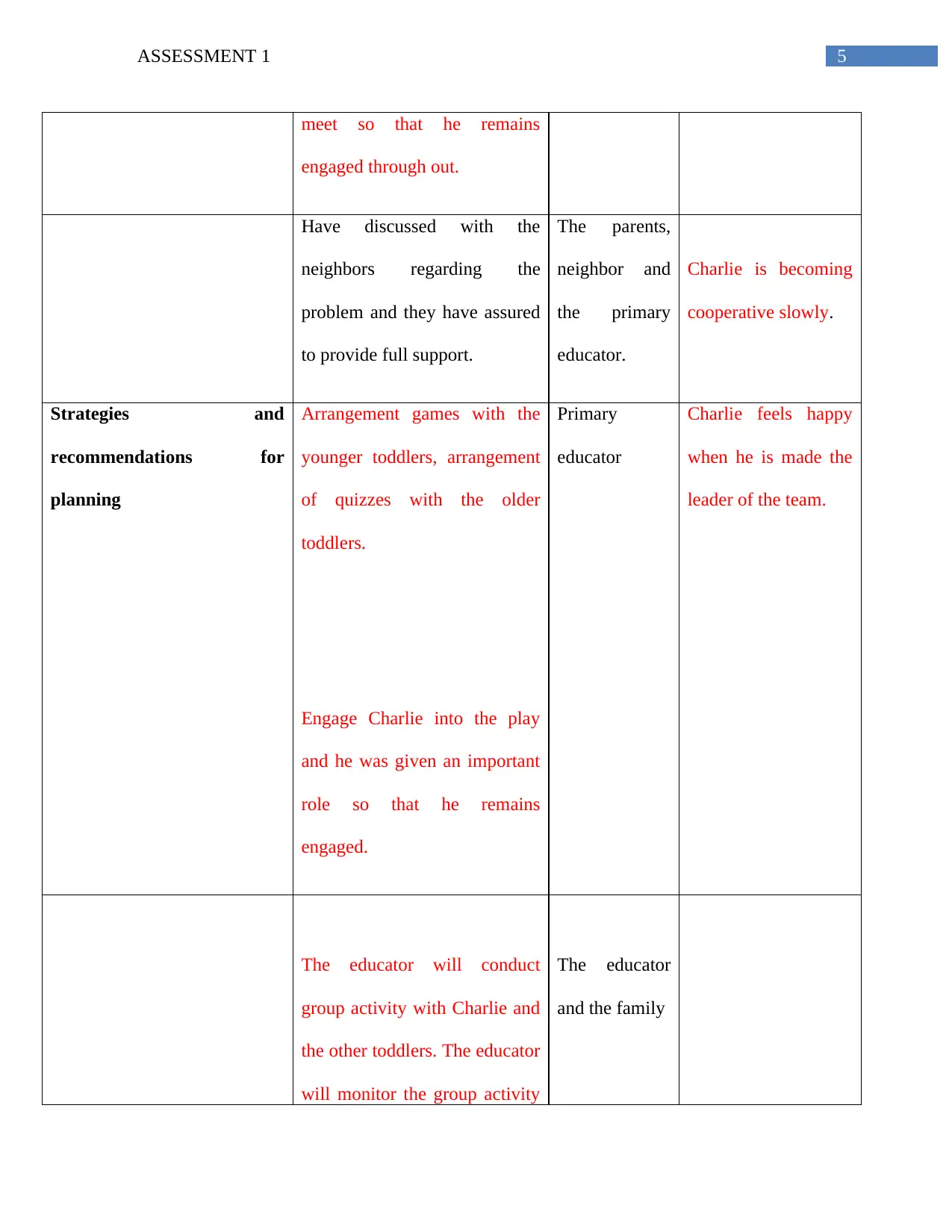
5ASSESSMENT 1
meet so that he remains
engaged through out.
Have discussed with the
neighbors regarding the
problem and they have assured
to provide full support.
The parents,
neighbor and
the primary
educator.
Charlie is becoming
cooperative slowly.
Strategies and
recommendations for
planning
Arrangement games with the
younger toddlers, arrangement
of quizzes with the older
toddlers.
Engage Charlie into the play
and he was given an important
role so that he remains
engaged.
Primary
educator
Charlie feels happy
when he is made the
leader of the team.
The educator will conduct
group activity with Charlie and
the other toddlers. The educator
will monitor the group activity
The educator
and the family
meet so that he remains
engaged through out.
Have discussed with the
neighbors regarding the
problem and they have assured
to provide full support.
The parents,
neighbor and
the primary
educator.
Charlie is becoming
cooperative slowly.
Strategies and
recommendations for
planning
Arrangement games with the
younger toddlers, arrangement
of quizzes with the older
toddlers.
Engage Charlie into the play
and he was given an important
role so that he remains
engaged.
Primary
educator
Charlie feels happy
when he is made the
leader of the team.
The educator will conduct
group activity with Charlie and
the other toddlers. The educator
will monitor the group activity
The educator
and the family
⊘ This is a preview!⊘
Do you want full access?
Subscribe today to unlock all pages.

Trusted by 1+ million students worldwide
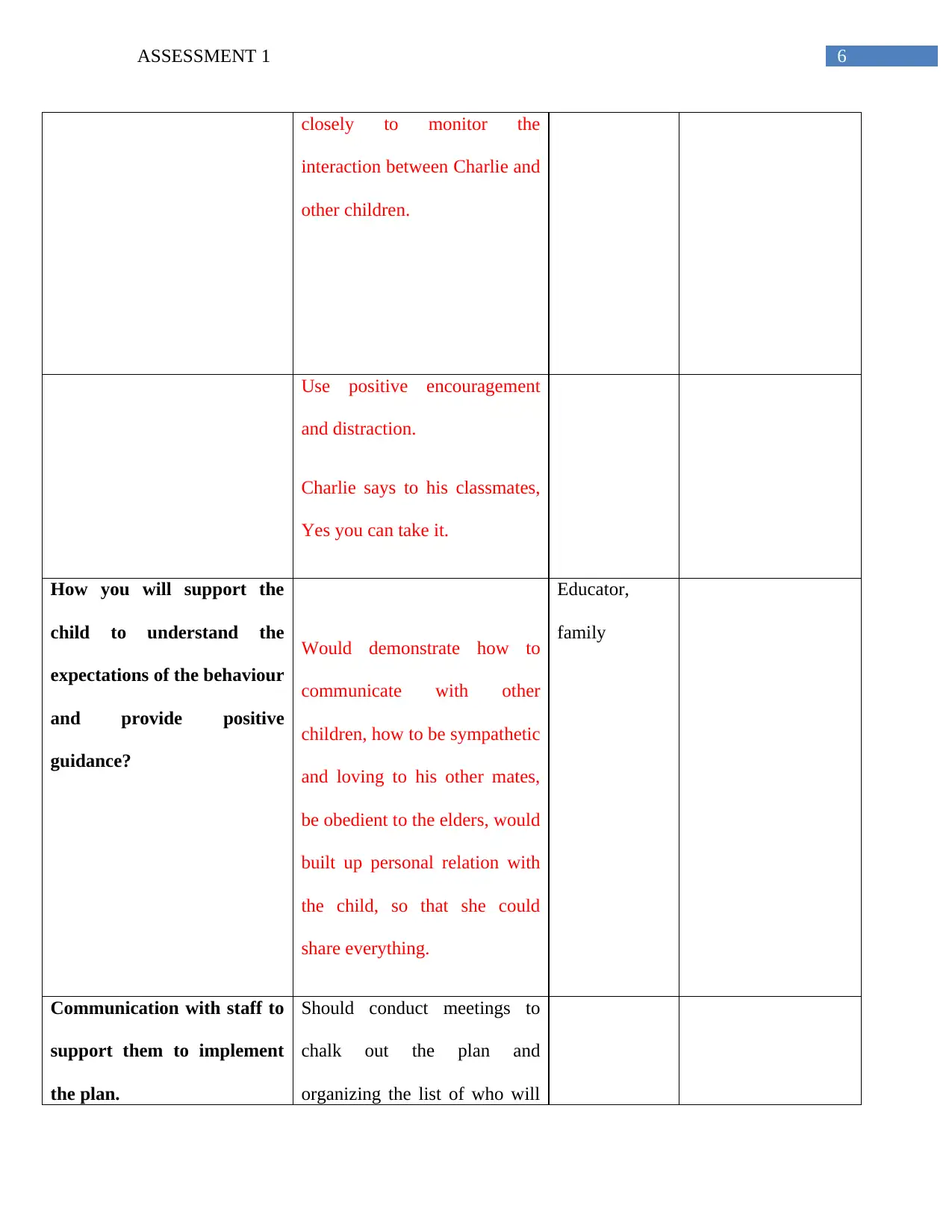
6ASSESSMENT 1
closely to monitor the
interaction between Charlie and
other children.
Use positive encouragement
and distraction.
Charlie says to his classmates,
Yes you can take it.
How you will support the
child to understand the
expectations of the behaviour
and provide positive
guidance?
Would demonstrate how to
communicate with other
children, how to be sympathetic
and loving to his other mates,
be obedient to the elders, would
built up personal relation with
the child, so that she could
share everything.
Educator,
family
Communication with staff to
support them to implement
the plan.
Should conduct meetings to
chalk out the plan and
organizing the list of who will
closely to monitor the
interaction between Charlie and
other children.
Use positive encouragement
and distraction.
Charlie says to his classmates,
Yes you can take it.
How you will support the
child to understand the
expectations of the behaviour
and provide positive
guidance?
Would demonstrate how to
communicate with other
children, how to be sympathetic
and loving to his other mates,
be obedient to the elders, would
built up personal relation with
the child, so that she could
share everything.
Educator,
family
Communication with staff to
support them to implement
the plan.
Should conduct meetings to
chalk out the plan and
organizing the list of who will
Paraphrase This Document
Need a fresh take? Get an instant paraphrase of this document with our AI Paraphraser
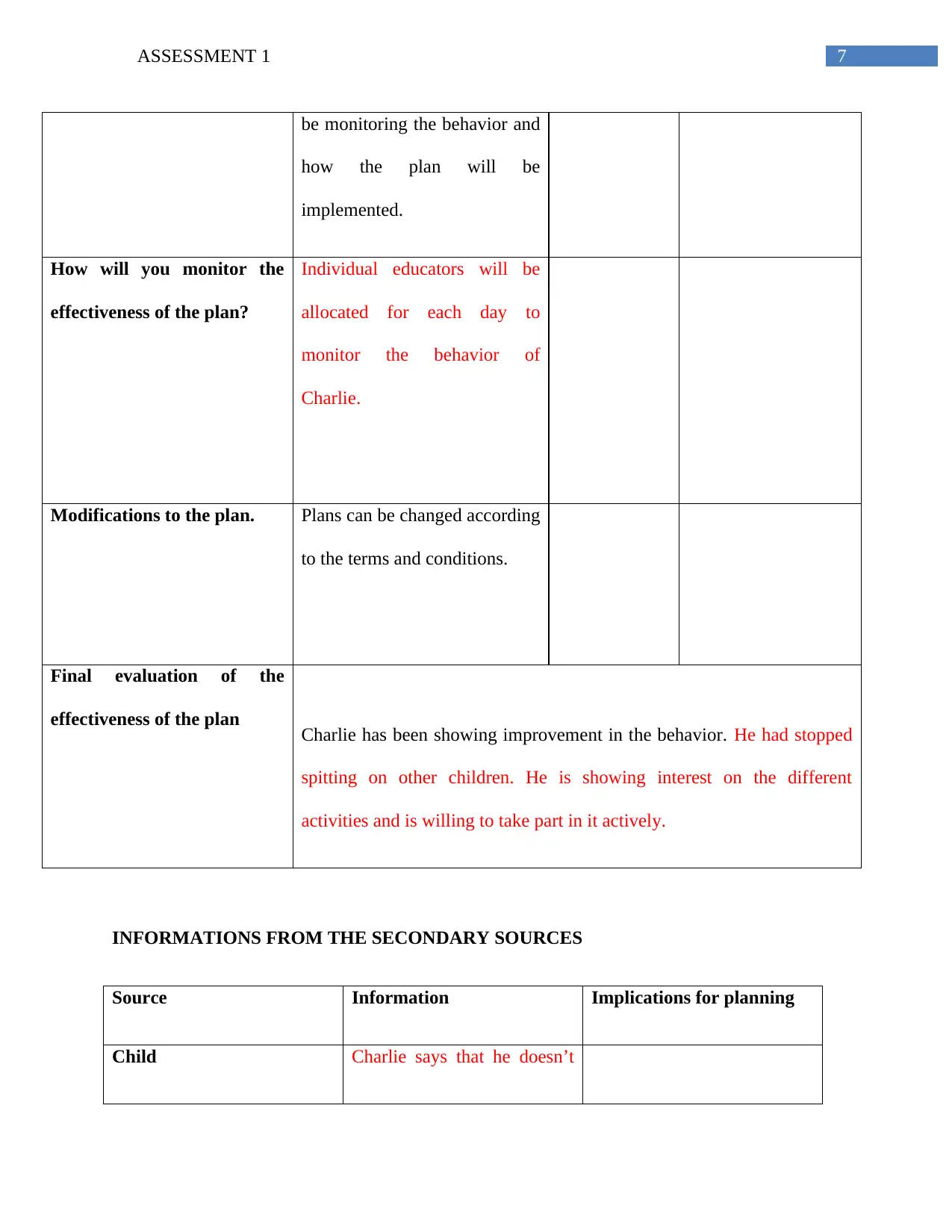
7ASSESSMENT 1
be monitoring the behavior and
how the plan will be
implemented.
How will you monitor the
effectiveness of the plan?
Individual educators will be
allocated for each day to
monitor the behavior of
Charlie.
Modifications to the plan. Plans can be changed according
to the terms and conditions.
Final evaluation of the
effectiveness of the plan Charlie has been showing improvement in the behavior. He had stopped
spitting on other children. He is showing interest on the different
activities and is willing to take part in it actively.
INFORMATIONS FROM THE SECONDARY SOURCES
Source Information Implications for planning
Child Charlie says that he doesn’t
be monitoring the behavior and
how the plan will be
implemented.
How will you monitor the
effectiveness of the plan?
Individual educators will be
allocated for each day to
monitor the behavior of
Charlie.
Modifications to the plan. Plans can be changed according
to the terms and conditions.
Final evaluation of the
effectiveness of the plan Charlie has been showing improvement in the behavior. He had stopped
spitting on other children. He is showing interest on the different
activities and is willing to take part in it actively.
INFORMATIONS FROM THE SECONDARY SOURCES
Source Information Implications for planning
Child Charlie says that he doesn’t
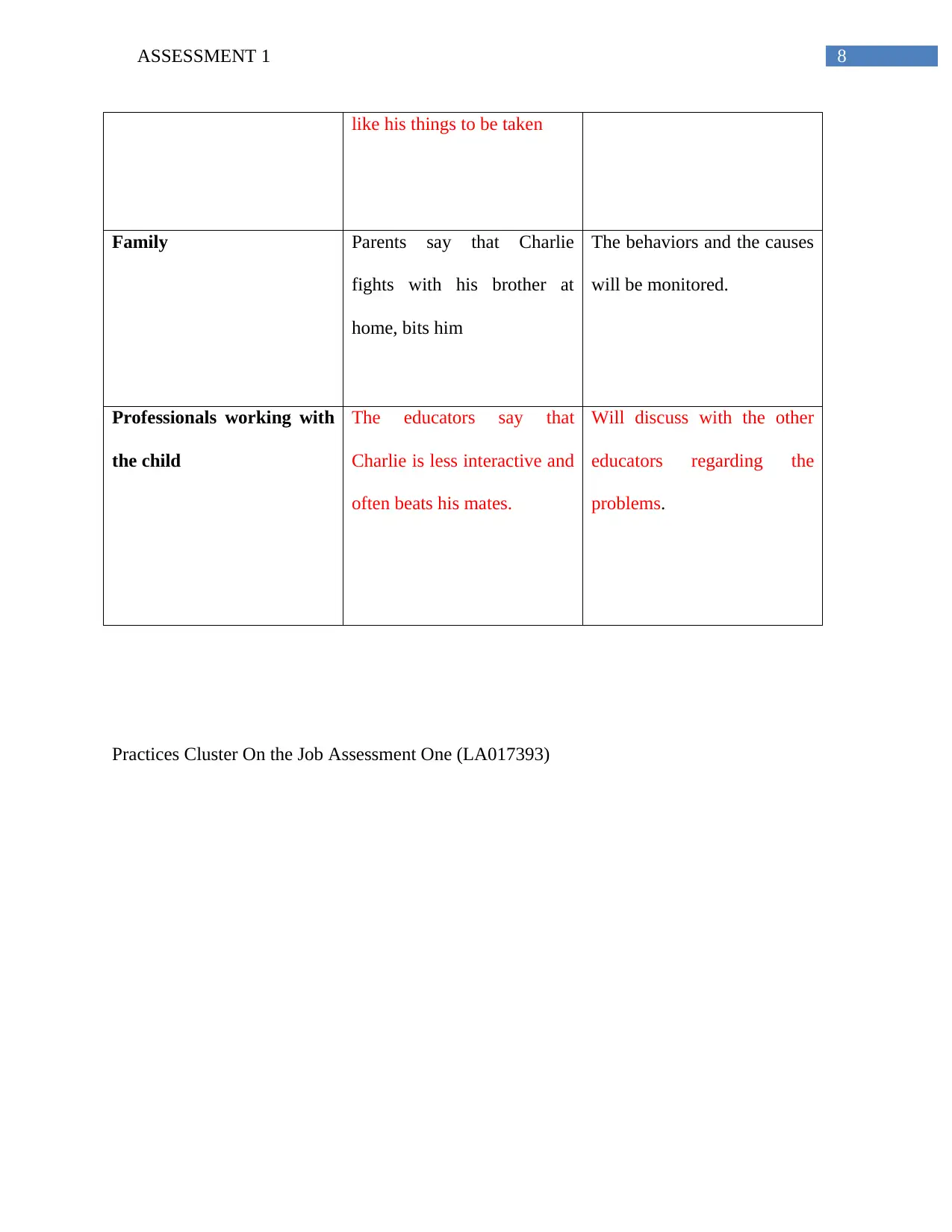
8ASSESSMENT 1
like his things to be taken
Family Parents say that Charlie
fights with his brother at
home, bits him
The behaviors and the causes
will be monitored.
Professionals working with
the child
The educators say that
Charlie is less interactive and
often beats his mates.
Will discuss with the other
educators regarding the
problems.
Practices Cluster On the Job Assessment One (LA017393)
like his things to be taken
Family Parents say that Charlie
fights with his brother at
home, bits him
The behaviors and the causes
will be monitored.
Professionals working with
the child
The educators say that
Charlie is less interactive and
often beats his mates.
Will discuss with the other
educators regarding the
problems.
Practices Cluster On the Job Assessment One (LA017393)
⊘ This is a preview!⊘
Do you want full access?
Subscribe today to unlock all pages.

Trusted by 1+ million students worldwide
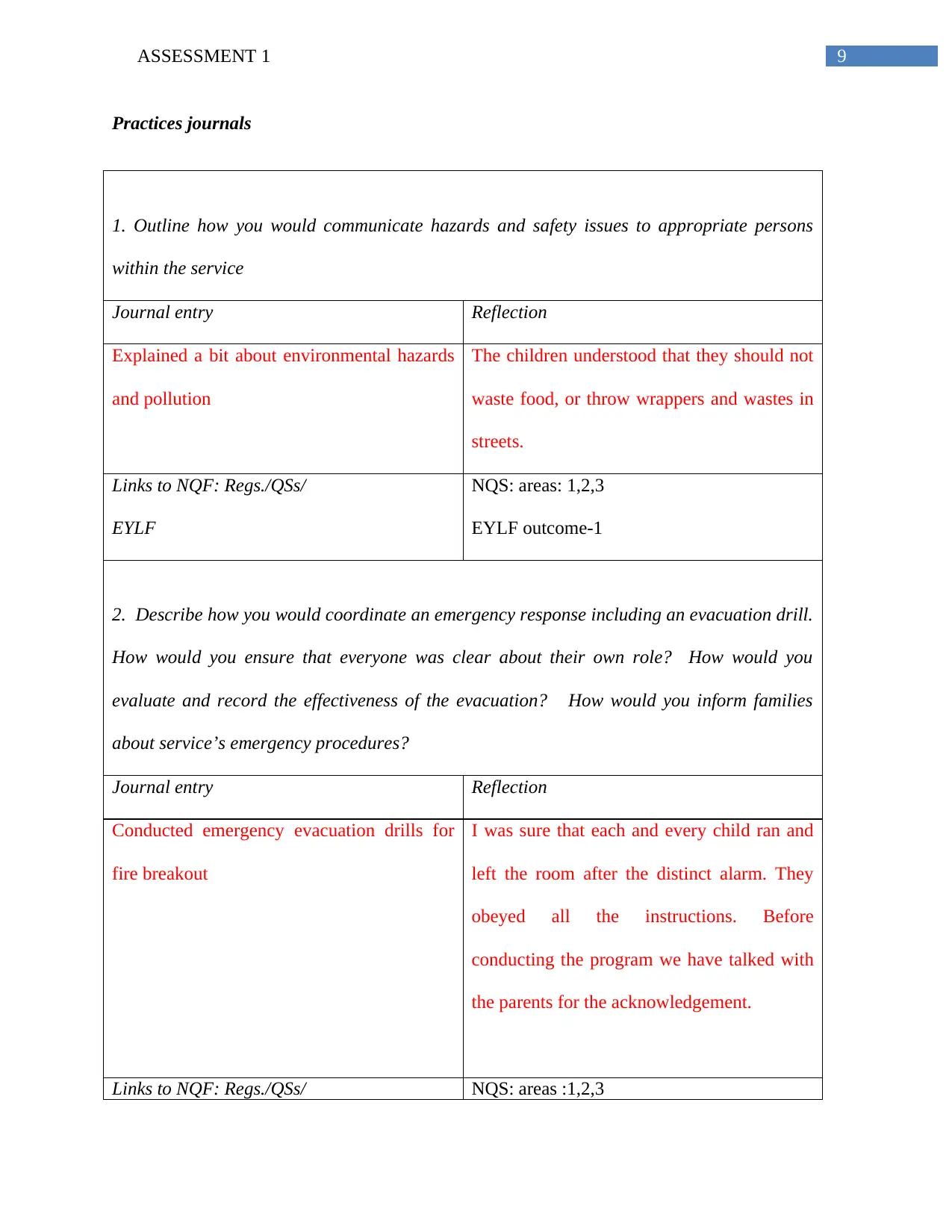
9ASSESSMENT 1
Practices journals
1. Outline how you would communicate hazards and safety issues to appropriate persons
within the service
Journal entry Reflection
Explained a bit about environmental hazards
and pollution
The children understood that they should not
waste food, or throw wrappers and wastes in
streets.
Links to NQF: Regs./QSs/
EYLF
NQS: areas: 1,2,3
EYLF outcome-1
2. Describe how you would coordinate an emergency response including an evacuation drill.
How would you ensure that everyone was clear about their own role? How would you
evaluate and record the effectiveness of the evacuation? How would you inform families
about service’s emergency procedures?
Journal entry Reflection
Conducted emergency evacuation drills for
fire breakout
I was sure that each and every child ran and
left the room after the distinct alarm. They
obeyed all the instructions. Before
conducting the program we have talked with
the parents for the acknowledgement.
Links to NQF: Regs./QSs/ NQS: areas :1,2,3
Practices journals
1. Outline how you would communicate hazards and safety issues to appropriate persons
within the service
Journal entry Reflection
Explained a bit about environmental hazards
and pollution
The children understood that they should not
waste food, or throw wrappers and wastes in
streets.
Links to NQF: Regs./QSs/
EYLF
NQS: areas: 1,2,3
EYLF outcome-1
2. Describe how you would coordinate an emergency response including an evacuation drill.
How would you ensure that everyone was clear about their own role? How would you
evaluate and record the effectiveness of the evacuation? How would you inform families
about service’s emergency procedures?
Journal entry Reflection
Conducted emergency evacuation drills for
fire breakout
I was sure that each and every child ran and
left the room after the distinct alarm. They
obeyed all the instructions. Before
conducting the program we have talked with
the parents for the acknowledgement.
Links to NQF: Regs./QSs/ NQS: areas :1,2,3
Paraphrase This Document
Need a fresh take? Get an instant paraphrase of this document with our AI Paraphraser
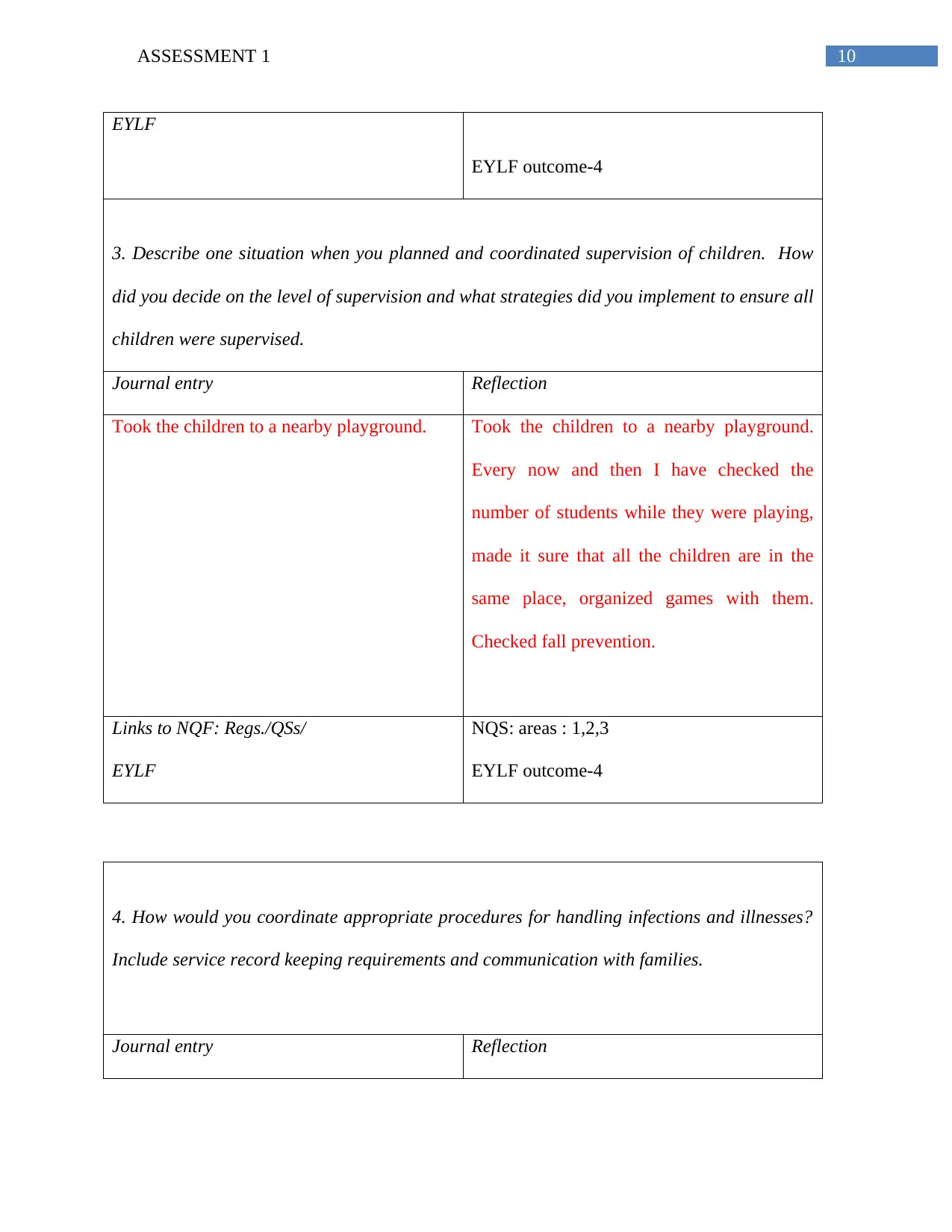
10ASSESSMENT 1
EYLF
EYLF outcome-4
3. Describe one situation when you planned and coordinated supervision of children. How
did you decide on the level of supervision and what strategies did you implement to ensure all
children were supervised.
Journal entry Reflection
Took the children to a nearby playground. Took the children to a nearby playground.
Every now and then I have checked the
number of students while they were playing,
made it sure that all the children are in the
same place, organized games with them.
Checked fall prevention.
Links to NQF: Regs./QSs/
EYLF
NQS: areas : 1,2,3
EYLF outcome-4
4. How would you coordinate appropriate procedures for handling infections and illnesses?
Include service record keeping requirements and communication with families.
Journal entry Reflection
EYLF
EYLF outcome-4
3. Describe one situation when you planned and coordinated supervision of children. How
did you decide on the level of supervision and what strategies did you implement to ensure all
children were supervised.
Journal entry Reflection
Took the children to a nearby playground. Took the children to a nearby playground.
Every now and then I have checked the
number of students while they were playing,
made it sure that all the children are in the
same place, organized games with them.
Checked fall prevention.
Links to NQF: Regs./QSs/
EYLF
NQS: areas : 1,2,3
EYLF outcome-4
4. How would you coordinate appropriate procedures for handling infections and illnesses?
Include service record keeping requirements and communication with families.
Journal entry Reflection
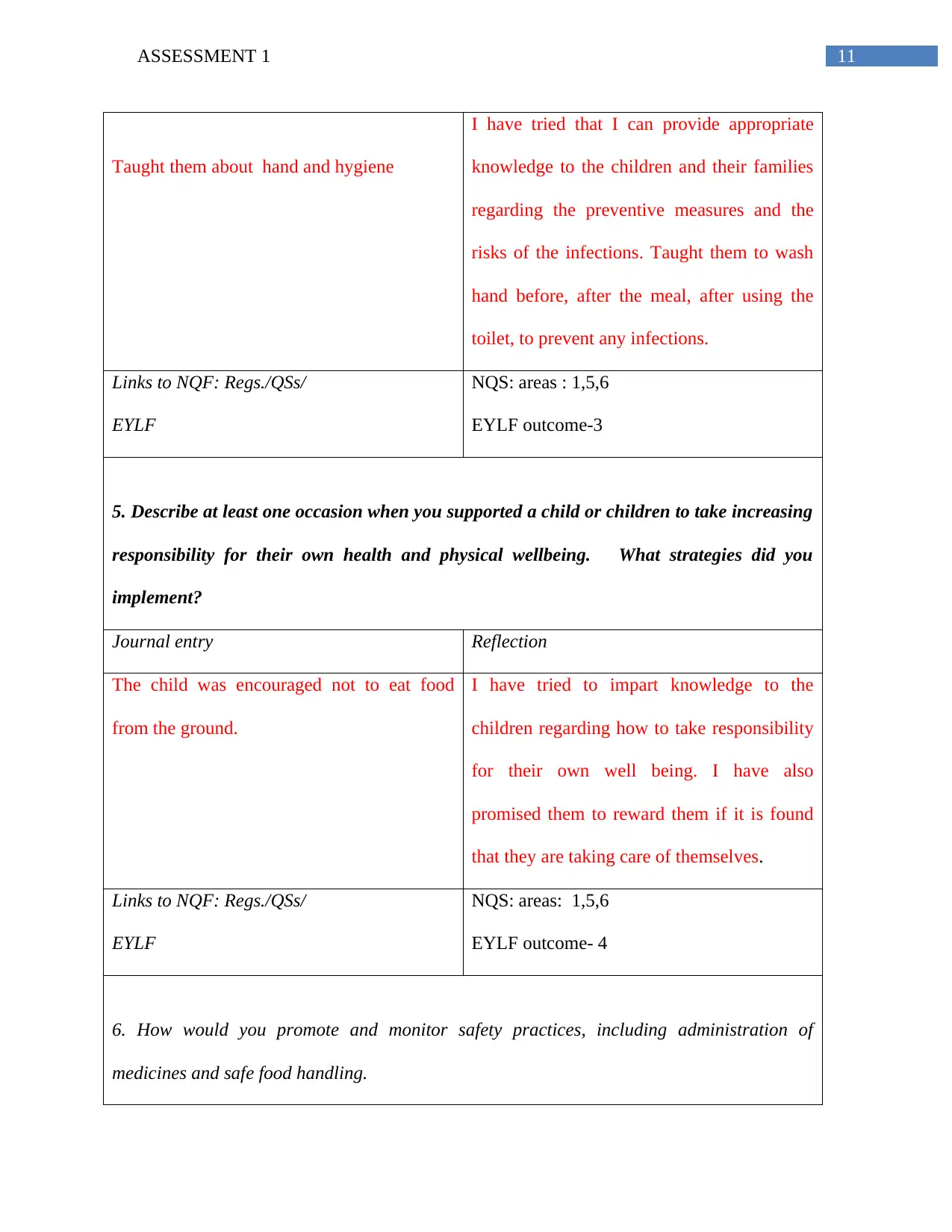
11ASSESSMENT 1
Taught them about hand and hygiene
I have tried that I can provide appropriate
knowledge to the children and their families
regarding the preventive measures and the
risks of the infections. Taught them to wash
hand before, after the meal, after using the
toilet, to prevent any infections.
Links to NQF: Regs./QSs/
EYLF
NQS: areas : 1,5,6
EYLF outcome-3
5. Describe at least one occasion when you supported a child or children to take increasing
responsibility for their own health and physical wellbeing. What strategies did you
implement?
Journal entry Reflection
The child was encouraged not to eat food
from the ground.
I have tried to impart knowledge to the
children regarding how to take responsibility
for their own well being. I have also
promised them to reward them if it is found
that they are taking care of themselves.
Links to NQF: Regs./QSs/
EYLF
NQS: areas: 1,5,6
EYLF outcome- 4
6. How would you promote and monitor safety practices, including administration of
medicines and safe food handling.
Taught them about hand and hygiene
I have tried that I can provide appropriate
knowledge to the children and their families
regarding the preventive measures and the
risks of the infections. Taught them to wash
hand before, after the meal, after using the
toilet, to prevent any infections.
Links to NQF: Regs./QSs/
EYLF
NQS: areas : 1,5,6
EYLF outcome-3
5. Describe at least one occasion when you supported a child or children to take increasing
responsibility for their own health and physical wellbeing. What strategies did you
implement?
Journal entry Reflection
The child was encouraged not to eat food
from the ground.
I have tried to impart knowledge to the
children regarding how to take responsibility
for their own well being. I have also
promised them to reward them if it is found
that they are taking care of themselves.
Links to NQF: Regs./QSs/
EYLF
NQS: areas: 1,5,6
EYLF outcome- 4
6. How would you promote and monitor safety practices, including administration of
medicines and safe food handling.
⊘ This is a preview!⊘
Do you want full access?
Subscribe today to unlock all pages.

Trusted by 1+ million students worldwide
1 out of 14
Your All-in-One AI-Powered Toolkit for Academic Success.
+13062052269
info@desklib.com
Available 24*7 on WhatsApp / Email
![[object Object]](/_next/static/media/star-bottom.7253800d.svg)
Unlock your academic potential
Copyright © 2020–2025 A2Z Services. All Rights Reserved. Developed and managed by ZUCOL.